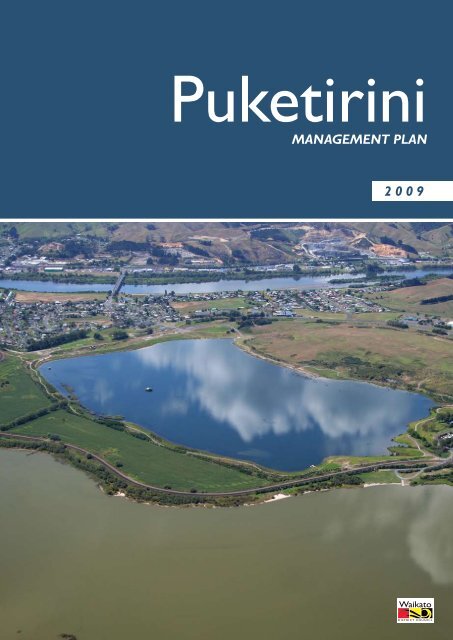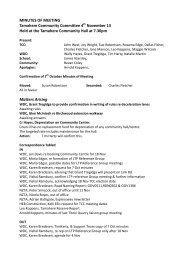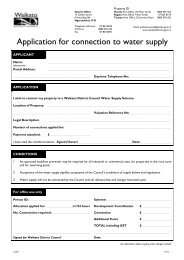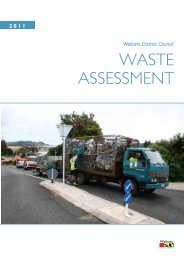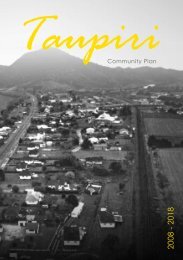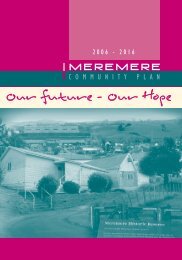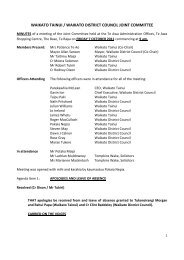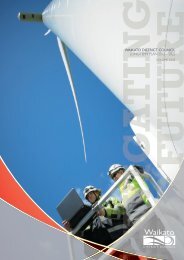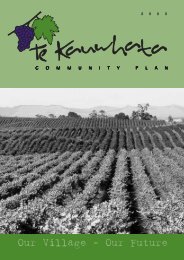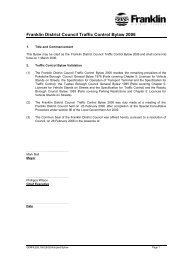Puketirini management plan - Waikato District Council
Puketirini management plan - Waikato District Council
Puketirini management plan - Waikato District Council
- No tags were found...
You also want an ePaper? Increase the reach of your titles
YUMPU automatically turns print PDFs into web optimized ePapers that Google loves.
<strong>Puketirini</strong>MANAGEMENT PLAN2 0 0 9
Photo courtesy of Solid Energy New Zealand Ltd
Table of ContentsTABLE OF CONTENTS 21.0 INTRODUCTION………………………………………………… 31.1 History of <strong>Puketirini</strong> 31.2 Purpose of this document 41.3 Legislative and Policy Planning Context 41.3.1 Public Works Act 1981 41.3.2 Reserves Act 1977 41.3.3 Resource Management Act 1991 41.3.4 Long-Term <strong>Council</strong> Community Plan 41.3.5 Reserves and Recreation Strategy 41.3.6 Bylaws 51.3.7 Deed of Settlement for the <strong>Waikato</strong> River 52.0 MANAGEMENT PLAN PROCESS……………………………… 63.0 DESCRIPTION OF PUKETIRINI………………………………… 73.1 Current uses 73.2 Lake water quality 73.3 Management of Park 83.4 <strong>Waikato</strong> Coalfields Museum 84.0 ISSUES…….......................…………………………………………… 94.1 Lake water quality 94.2 Competition for use of lake 94.3 Effect of recreational activities on environmental quality 94.4 Safety 94.5 Impact on surrounding neighbours 104.6 Access 104.7 Funding 105.0 MANAGEMENT PLAN VISION, OBJECTIVES AND POLICIES… 115.1 Management Plan Vision 115.2 Management Plan Objectives and Policies 115.2.1 Objective 1 - Environmental Quality 115.2.2 Objective 2 - Recreational Opportunities 135.2.3 Objective 3 - Safety 145.2.4 Objective 4 - Noise control 155.2.5 Objective 5 - Facility development 155.2.6 Objective 6 - Cultural and historical significance of <strong>Puketirini</strong> 165.2.7 Objective 7 - Signage 175.2.8 Objective 8 - Funding 176.0 FUTURE DEVELOPMENTS …………………………………… 186.1 Schedule of potential developments 18REFERENCES……………………………………………………………… 20APPENDIX 1: SELECTED HISTORICAL TIMELINEOF PUKETIRINI DEVELOPMENT………………………………………… 21APPENDIX 2: PUKETIRINI EVENT RULES………………………………… 22PUKETIRINI MANAGEMENT PLAN2009
1.0 INTRODUCTION1.1 History of <strong>Puketirini</strong>“<strong>Puketirini</strong>” is the original name of the area of land which the park is situated within. The name “<strong>Puketirini</strong>”means “the hills and streams”, “Puke” meaning “hills” and “Tirini” meaning “streams”.The area comprising <strong>Puketirini</strong> was predominantly in private ownership prior to being obtained by the Crownfor coal mining operations and state housing purposes between 1940 and 1980. The original lake, LakeRotoiti, became Crown land in 1865, and was earmarked for coal mining in 1929. Lake Rotoiti was eventuallyconsidered dry land in 1986, due to it being drained for mining.The site was first mined by State Coal Mines and then by Coal Corporation. The area comprising <strong>Puketirini</strong> wasvested and transferred from Crown ownership to Coal Corporation ownership in 1986. Coal Corporation wasrenamed Solid Energy New Zealand Limited (Solid Energy) in 1996.Mining ended at Weavers Opencast Mine in December 1993, after which Solid Energy began a project torehabilitate the disused mine into a lake. This is the first New Zealand coal pit of its size to be transformed intoa lake (Balvert, 2006). In 2003 <strong>Puketirini</strong> was opened for off-water recreational activities.In December 2006 <strong>Waikato</strong> <strong>District</strong> <strong>Council</strong> (<strong>Council</strong>) acquired from Solid Energy approximately 104 hectares(refer to Figure 1) for a public work (for amenity purposes) under the Public Works Act 1981. This parcelof land includes a lake that has an approximate depth of 64 metres, with a surface area of approximately 54hectares (Balvert, 2006).A more detailed historical timeline can be found in Appendix 1.
1.2 Purpose of this documentThis document sets out the future development, <strong>management</strong> and use of <strong>Puketirini</strong>.1.3 Legislative and Policy Planning ContextThere are several legislative and policy <strong>plan</strong>ning documents that affect the development, <strong>management</strong> and use of<strong>Puketirini</strong>. <strong>Waikato</strong> <strong>District</strong> <strong>Council</strong> obtained <strong>Puketirini</strong> under the Public Works Act 1981; however, a reserve<strong>management</strong> <strong>plan</strong> process has been followed for the development of this <strong>plan</strong>. <strong>Puketirini</strong> must also follow relevant<strong>Council</strong> <strong>plan</strong>ning documents and policy, as well as other governmental body policies as necessary, such as <strong>Waikato</strong>Regional <strong>Council</strong>’s Navigation Safety Bylaw.1.3.1 Public Works Act 1981<strong>Puketirini</strong> was acquired by <strong>Waikato</strong> <strong>District</strong> <strong>Council</strong> from Solid Energy New Zealand Limited under the Public Works Act1981 for amenity purposes.1.3.2 Reserves Act 1977Although <strong>Puketirini</strong> is not administered under the Reserves Act 1977, a Reserves Act <strong>management</strong> <strong>plan</strong> process has beenfollowed as this is considered a sound approach to developing a <strong>management</strong> <strong>plan</strong> for this area.A reserve <strong>management</strong> <strong>plan</strong> provides guidance for the future development, <strong>management</strong>, and use of a reserve (orreserves). This <strong>management</strong> <strong>plan</strong> will be reviewed from time to time.1.3.3 Resource Management Act 1991The purpose of the Resource Management Act 1991 is to promote the sustainable <strong>management</strong> of natural and physicalresources. The Resource Management Act 1991 provides regulatory mechanisms that have an impact on type and effectof permitted behaviour at <strong>Puketirini</strong>.<strong>Waikato</strong> <strong>District</strong> <strong>Council</strong>’s <strong>District</strong> Plan has been developed in accordance with the Resource Management Act 1991.The <strong>District</strong> Plan provides rules (e.g. noise control) that will affect the use and <strong>management</strong> of <strong>Puketirini</strong>.1.3.4 Long-Term <strong>Council</strong> Community PlanThe <strong>Waikato</strong> <strong>District</strong> Long Term <strong>Council</strong> Community Plan (LTCCP) is a long-term community-<strong>plan</strong>ning document thatprovides a road map for the future direction of the <strong>Waikato</strong> <strong>District</strong>. It is a ten-year <strong>plan</strong> and is reviewed every threeyears.The LTCCP identifies <strong>Council</strong>’s overall budget, which is decided upon through consideration of all <strong>Council</strong>’s functions.Funding decisions relating to <strong>Puketirini</strong> will be made within this broader context.1.3.5 Reserves and Recreation Strategy<strong>Waikato</strong> <strong>District</strong> <strong>Council</strong>’s Reserves and Recreation Strategy defines <strong>Council</strong>’s function regarding the provision ofrecreational facilities including the purchase, development and sale of reserves. The aim of this strategy is to develop aframework for the provision of facilities that is consistent and systematic. This framework has been developed to ensurecommunities receive maximum benefit from <strong>Council</strong> expenditure.This strategy sets out objectives and policies that identify the principles and process for decision-making related toreserve land.PUKETIRINI MANAGEMENT PLAN2009
1.3.6 BylawsThere are existing bylaws that apply to the use of <strong>Council</strong> land and may impact on user behaviour at <strong>Puketirini</strong>. Bylawsapplying to <strong>Puketirini</strong> include the Dog Control Bylaw 2007 and the Parking, Traffic Control and the Public Places Bylaw2007.Lake <strong>Puketirini</strong> is temporarily exempt from S1.22.2 (c) of the <strong>Waikato</strong> Regional <strong>Council</strong>’s Navagation Safety Bylaw 2006.This has reduced the distance that any vessel exceeding five knots must be from a craft flying a divers flag to 50 metres.The Navigation Safety Bylaw identifies safe practices when using navigable waterways.1.3.7 Deed of Settlement for the <strong>Waikato</strong> RiverIn August 2008 <strong>Waikato</strong>-Tainui and the Crown signed a Deed of Settlement for the <strong>Waikato</strong> River, which sought toaddress Crown confiscation of land (Raupatu) during the 1860s, which denied <strong>Waikato</strong>-Tainui of their rights and interestsin the <strong>Waikato</strong> River. <strong>Waikato</strong>-Tainui’s definition of the <strong>Waikato</strong> River applies to <strong>Puketirini</strong>, being that the <strong>Waikato</strong> Riverextends from the Huka Falls to the mouth, and includes its waters, banks and beds (and all minerals under them) andits streams, waterways, tributaries, lakes, aquatic fisheries, vegetation ,floodplains, and wetlands, as well as its metaphysicalbeing.The purpose of this agreement is to recognise the particular significance of the <strong>Waikato</strong> River to <strong>Waikato</strong>-Tainui, and toformalise the commitment of both parties in pursuing a new era of co-<strong>management</strong> in relation to the <strong>management</strong> ofthe <strong>Waikato</strong> River.The overarching purpose of the settlement is to restore and protect the health and wellbeing of the <strong>Waikato</strong> River forfuture generations.The Deed of Settlement provides for the establishment of the Guardians of the <strong>Waikato</strong> River, which is responsibleto promote, and work to achieve the overarching purpose of the settlement. The Guardians will also promote, coordinate,facilitate and supervise the implementation of the vision and strategy. The vision and strategy was developed bythe Guardians Establishment Committee who may hold office until the Guardians proper have been established. TheGuardians will provide for a whole of the river approach and will be governed by Iwi of the <strong>Waikato</strong> River and an equalnumber of Crown representatives.A <strong>Waikato</strong> River Statutory Board will be developed to assist in the on-going <strong>management</strong> of the <strong>Waikato</strong> River, andensure future river <strong>management</strong> activities align with the vision and strategy for the <strong>Waikato</strong> River. The statutory boardis <strong>Waikato</strong>-Tainui’s expression of its mana whakahaere (rights, authority and control) and will be responsible for itstraditions between Karapiro and the Mouth of the <strong>Waikato</strong> River.A Statutory Board Establishment Committee will be established to examine territorial authority roles and responsibilitiesthat may be transferred to the <strong>Waikato</strong> River Statutory Board or the <strong>Waikato</strong> Raupatu River Trust.
2.0 MANAGEMENT PLAN PROCESSThe diagram below depicts the <strong>Puketirini</strong> <strong>management</strong> <strong>plan</strong> process:Public advised via Public Notice of <strong>Council</strong>’s intention to preparea <strong>management</strong> <strong>plan</strong> and written suggestions are invited over aone-month periodWritten suggestions received and additional consultationundertaken help to form a draft <strong>management</strong> <strong>plan</strong>CommunityConsultation GroupConsultationwith IwiDraft <strong>management</strong> <strong>plan</strong> developed and presented for approvalto Strategic CommitteeDraft <strong>management</strong> <strong>plan</strong> redrafted and presented for approval to<strong>Waikato</strong> <strong>District</strong> <strong>Council</strong>’s Policy CommitteeDraft <strong>management</strong> <strong>plan</strong> published and public submissions invitedSubmissions reviewed and also heard (if requested) by the<strong>management</strong> <strong>plan</strong> committeeManagement <strong>plan</strong> redraftedModified <strong>plan</strong> approved by the <strong>management</strong> <strong>plan</strong> committeeFinal Plan published and publicly notified.PUKETIRINI MANAGEMENT PLAN2009
3.0 DESCRIPTION OF PUKETIRINI3.1 Current uses<strong>Puketirini</strong> is utilised by the public regularly for off-water recreational activities, such as walking, running, and cycling. Asignificant number of community activities have also taken place at this site.Lake <strong>Puketirini</strong> was opened for on-water recreational activities between March and May 2007. Lake access was grantedby way of a key system to control user access to the lake. The purpose of this trial was to determine what issues mayoccur when allowing recreational activities on the lake. Lake <strong>Puketirini</strong> has been re-opened for public use in 2007/08 and2008/09 between November and May, re-utilising a key system.The New Zealand School of Commercial Diver Training regularly uses the lake. It is considered an ideal location fordiver training due to the lake’s depth and water quality. The diving school has a commercial agreement with <strong>Council</strong>.Part of <strong>Puketirini</strong> is leased to Wel Networks Limited for substation operations located within the park boundary.The <strong>Waikato</strong> Coalfields Museum has placed the Huntly Railway Station building at the <strong>Puketirini</strong> as part of <strong>plan</strong>s torelocate <strong>Waikato</strong> Coalfields Museum to the park.3.2 Lake water qualityWithin the <strong>Waikato</strong> <strong>District</strong>, the lake is unique due to its high water quality. Monitoring at the lake and western drain hasbeen undertaken on a quarterly basis since 1996. The pH level within the drain has decreased approximately one unitbetween 1996 and 2007.The extreme depth of the lake compared to its small area means mixing of the water column is poor. As a result thewaters below 20 metres or so may be semi-permanently devoid of dissolved oxygen. Fish and other organisms areunlikely to be present in oxygen depleted waters, and there is a risk of contaminants being released from the bottomsediments into the overlying water. The lake is probably still coming to equilibrium (i.e. “settling down”). Recent researchsuggest the lake’s water quality may decline somewhat as it approaches equilibrium.To provide a comparison of water quality between Lake <strong>Puketirini</strong> and other lakes within the <strong>Waikato</strong> region, Lake<strong>Puketirini</strong> water quality is better than that at Lake Waahi, but is of lower quality than Lake Taupo. Lake <strong>Puketirini</strong>contains higher concentrations of phosphorus and algae, and the waters are less clear. It is classified as “mesotrophic”(Balvert, 2006).The following table provides annual average water quality in Lake Taupo, Lake <strong>Puketirini</strong>, and Lake Waahi:1Table 1: Total phosphorous, chlorophyll a and secchi depth within Lake Taupo, Lake <strong>Puketirini</strong>, and Lake WaahiLakeTaupo2 3Lake<strong>Puketirini</strong>LakeWaahiTotal phosphorus (mg/m3) 6 12 80Chlorophyll a (mg/m3) 1 3.5 74Secchi disc depth (m) 15 4 0.41 A mesotrophic lake contains a moderate amount of nutrients.
3.3 Management of ParkA Strategic Committee has been established to provide general oversight, assist the development of a <strong>management</strong> <strong>plan</strong>,and deal with strategic issues related to the park.3.4 <strong>Waikato</strong> Coalfields Museum<strong>Puketirini</strong> is the proposed site for the new <strong>Waikato</strong> Coalfields Museum. The museum will be located at the Easternend of the park, close to the main entrance. The museum complex will consist of a main building and several auxiliarybuildings. Landscaping will be used to integrate the museum development into the rest of the park.2 Lake Taupo is oligotrophic lake. An oligotrophic lake contains low levels of nutrients and algae. Lake Taupo dataobtained from Environment <strong>Waikato</strong> database (2008).3 Lake Waahi is a hypertrophic lake. A hypertrophic lake contains a very high level of nutrients, and usually haslow water clarity and intense algal blooms. Lake Waihi data obtained from Environment <strong>Waikato</strong> database (2008).PUKETIRINI MANAGEMENT PLAN2009
4.0 ISSUESSeveral issues were identified as needing to be addressed through <strong>management</strong> <strong>plan</strong> objectives and policies for <strong>Puketirini</strong>:4.1 Lake water qualityEnsuring lake water remains of high quality is of paramount importance and requires limiting the level of nutrientsflowing into the lake. Nutrient inflows, particularly those due to non-source point run-off from land use within the lake’scatchment area, need to be minimised. A high nutrient level will increase the level of algae within the lake, potentiallydecreasing the suitability of the lake for contact recreational activities.Pest fish, such as koi carp (Cyprinus carpio), are already within the lake. Koi carp were originally introduced into NewZealand as an ornamental fish; however, have become a significant pest within many New Zealand lakes. Koi carp stir uplake sediment particles, due to their feeding habits, destroying lake vegetation and releasing nutrients into the water. Koicarp, and other pest fish, are identified as animal pests under Environment <strong>Waikato</strong>’s Regional Pest Management Strategyand these species need to be controlled.4.2 Competition for use of lakeA high number of user groups have expressed their interest in participating in on-water recreational activities. Lake userswere identified as using the lake for the following activities: motorised casual activities, motorised events, non-motorisedcasual activities, and non-motorised events. There is particular competition for use of the lake between motorised andnon-motorised watercraft user groups. There is also the need to balance the number of events held on the lake withgeneral community use. The high competition for use of the lake means there is the need for careful <strong>plan</strong>ning to ensurethere is an optimal blend of recreational uses, such as balancing waka ama, yachting, water skiing and other identified lakeuses.4.3 Effect of recreational activities on environmentalqualityRecreational use of <strong>Puketirini</strong> area may impact on park environs. For example, boat use may result in habitat disturbance.Recreational use of <strong>Puketirini</strong> will need to be balanced against environmental quality objectives and policies.4.4 SafetyCommunity members have expressed safety concerns for areas around <strong>Puketirini</strong> where passive recreational activitiestake place. Safety is particularly a concern for walking and running around <strong>Puketirini</strong>, where there are areas of vegetationthat allow for seclusion around some areas of the lake. Safety issues also need to be considered when developingfacilities. Unauthorised motor biking around <strong>Puketirini</strong> is also a cause for concern for walkers and runners.Navigation safety is an issue that needs to be considered when determining lake uses and developing a schedule for lakeactivities and events. Additionally, there is deep water close to the lakeshore that may pose a safety issue for lake users.There have been a number of fires lit upon dry vegetation surrounding the park. The Huntly Fire Brigade has been calledto <strong>Puketirini</strong> on several occasions.Vandalism of <strong>Puketirini</strong> facilities is an issue that needs to be weighed when considering the development of facilities.
4.5 Impact on surrounding neighboursNoise from motorised boating activities can be an issue for residents living close to <strong>Puketirini</strong>. The level of noisegenerated from motorised boats is dependant on the type of boat used on the lake.4.6 AccessMotor biking is occurring at the reserve despite efforts to prohibit access to motorised vehicles through the installation ofwire fences. Motorised vehicle access within <strong>Puketirini</strong> should be limited to specific areas and for identified purposes.Boat ramp access is controlled through the use of a key system that provides rules and regulations for on-water activities.The use of the key system assists <strong>Council</strong> in managing user behaviour and the length of season for on-water activities.The key system may need to be reviewed in response to changing lake issues and user demand.4.7 FundingSignificant funding is needed to develop and maintain <strong>Puketirini</strong>, and <strong>Council</strong> funds are limited. <strong>Council</strong> will need to seekadditional funding for external sources. Funding constraints will affect the timing and extent of park development.PUKETIRINI MANAGEMENT PLAN102009
5.0 MANAGEMENT PLANVISION, OBJECTIVES ANDPOLICIES5.1 Management Plan VisionThe vision of <strong>Puketirini</strong> is:To protect and enhance the health and well-being of <strong>Puketirini</strong>,and develop <strong>Puketirini</strong> for community useThe health and well-being of <strong>Puketirini</strong> is of significant importance to Iwi and the wider community, and the <strong>management</strong><strong>plan</strong> should align with the vision and strategy for the <strong>Waikato</strong> River.It is expected that <strong>Puketirini</strong> will become a significant recreational asset for Huntly and the <strong>Waikato</strong> region. <strong>Puketirini</strong> alsohas the potential to provide a venue for national on-water and off-water events. Protecting and developing <strong>Puketirini</strong>as a recreational resource will require the protection and enhancement of the park’s ecological values. This may meanthat recreational use and development of <strong>Puketirini</strong> is dependant on its impact on park, particularly lake, environs.Recreational use of <strong>Puketirini</strong> needs to be carefully considered to ensure that ecological values are protected whilstensuring as many recreational opportunities as possible are made available to the public.5.2 Management Plan Objectives and PoliciesSeveral objectives have been developed to guide the development, <strong>management</strong> and use of <strong>Puketirini</strong>. These objectivesseek to maximise the vision of the park as a recreational resource and an ecological asset for local, regional, and nationalcommunities.5.2.1 Objective 1 - Environmental QualityObjective:The lake remains suitable for contact recreation, and <strong>Puketirini</strong> ecological values are protected and developed.Ex<strong>plan</strong>ation:11Protecting the lake’s water quality is a high priority. A significant factor that will affect the lake’s water quality is the levelof nutrients flowing into the lake, particularly from non-point run off. A number of strategies can be implemented toreduce the level of nutrients flowing into the lake. Land outside of <strong>Puketirini</strong> is not covered by this <strong>plan</strong>. <strong>Council</strong> willseeks to work in partnership with landowners on matters that might affect lake health. Preventing lake erosion is an issuethat may also need to be addressed.
There is also the potential for further pest fish, particularly more koi carp (Cyprinus carpio), to migrate into the lake.efforts will be undertaken to eliminate Koi carp and other pest fish within the lake and to prevent re-infestation.AllThere are wetland areas within <strong>Puketirini</strong> that will require further development and maintenance to develop these areasinto an ecological asset. Wetland areas assist in reducing the flow of nutrients into the lake.Wildlife needs to be catered for within <strong>Puketirini</strong>. <strong>Council</strong> seeks to develop and enhance wetland habitat and vegetationaround the park.Policies:a.b.c.d.e.<strong>Puketirini</strong> should be developed in a way that results in a minimum flow of nutrients and other contaminants into thelake.The lakebed and shoreline should be stable to avoid nutrient release into the water.Pest fish species should be controlled or eliminated.Ecological areas within <strong>Puketirini</strong>, such as wetland areas, should be developed.Suitable habitats for wildlife should be created through the development of wetland areas and a general increase invegetation around <strong>Puketirini</strong>.Implementation:I.II.III.IV.V.VI.VII.VIII.IX.X.XI.XII.XIII.XIV.XV.XVI.XVII.XVIII.Analysis of lake and western drain water quality data will be undertaken regularly, and monitoring and analysis ofphosphorous, chlorophyll a, and secchi depth levels will be undertaken.Pest fish populations will be controlled through installation of a barrier that prevents pest fish migrating into thelake from Lake Waahi but allows native fish and eel migration, and through eradication programmes.Planting of habitat areas on private land surrounding the reserve, and best practice land <strong>management</strong> practices,will be encouraged through liaison with surrounding landowners.Drainage and stormwater <strong>management</strong> practices within the lake’s catchment area, to enhance the quality ofwater flowing into the lake, will be promoted through liaison with surrounding landowners.Lake bank erosion will be monitored and lake <strong>management</strong> actions implemented as necessary, with a preferencefor riparian <strong>plan</strong>ting, but with the possible use of protection structures at the Eastern end of the lake.Silt traps will be developed at appropriate locations to trap sediment and nutrient inflows.Riparian <strong>plan</strong>t species will be <strong>plan</strong>ted at the lake outlet and Eastern drain, with eco-sourced <strong>plan</strong>t species utilisedas much as practicable.Flap gates will be used to prevent water from Lake Waahi entering the lake.Direct storm water discharges from car parks to the lake will be avoided.Ongoing advice will be sought from <strong>Waikato</strong> Regional <strong>Council</strong> regarding water quality issues.Plant and animal pest control activities will be undertaken as appropriate.A wetland <strong>management</strong> <strong>plan</strong> will be developed that addresses issues such as <strong>plan</strong>t and animal pests, <strong>plan</strong>ting, andfencing issues.A <strong>plan</strong>ting programme will be developed and will utilise native <strong>plan</strong>t species as much as possible, with preferencegiven to <strong>plan</strong>ting locally sourced species.Collaboration with other governmental agencies (particularly <strong>Waikato</strong> Regional <strong>Council</strong>), Iwi, and communitygroups will occur as appropriate to develop, maintain, and create awareness relating to the ecological health ofpark land, lake, and wetland habitats.Suitable habitats for wildlife will be created through the development of wetland areas and a general increase invegetation around <strong>Puketirini</strong>.Sampling and monitoring of lake algal levels will be undertaken as appropriate.An on-going relationship with <strong>Waikato</strong>-Tainui will be developed to protect and enhance <strong>Puketirini</strong>’s ecologicalvalues.Advocate that <strong>Waikato</strong> Regional <strong>Council</strong> classify the lake as a contact recreation venue and recommend thatthis be reflected in discharge consent conditions and regional <strong>plan</strong>s.PUKETIRINI MANAGEMENT PLAN122009
5.2.2 Objective 2 - Recreational OpportunitiesObjective:Recreational opportunities are maximised to allow for local, regional, and national activities, and casual and organisedevents.Ex<strong>plan</strong>ation:<strong>Puketirini</strong> is regularly used for walking, running, and cycling, and a number of community organisations have alreadyutilised the tracks around <strong>Puketirini</strong> for their events. <strong>Council</strong> seeks to increase the accessibility of current walking andcycling tracks and increase the number of tracks around <strong>Puketirini</strong> as appropriate.A high level of interest in on-water recreational activities on the lake will require careful <strong>plan</strong>ning to ensure the number ofon-water events held at the lake is balanced with general community access. The conflict between motorised and nonmotorisedwatercraft activities will also be considered when determining lake activity scheduling.Jet skis are prohibited on the lake as specified under <strong>Waikato</strong> Regional <strong>Council</strong>’s Navigation Safety Bylaw 2006; however,exemption from this bylaw can be sought for organised events by contacting both <strong>Waikato</strong> Regional <strong>Council</strong> and<strong>Waikato</strong> <strong>District</strong> <strong>Council</strong>.Policy:a.b.c.Walking and cycling tracks should be developed and maintained.Easy access to the lake will be maintained where swimming or boat launching is desirable.Motorised and non-motorised boating should occur at the lake provided there are no significant adverseenvironmental effects related to these activities.Implementation:I.II.III.IV.V.VI.VII.VIII.IX.A suitable number of walking and cycling tracks will be developed dependant on user demand.Walking and cycling tracks will be maintained to an appropriate standard.The dual walkway-cycleway around the lake will be retained and maintained to pushchair standard.Walking tracks will be upgraded to provide wheelchair access adjacent to car parks.The existing boat ramp will be maintained and additional boat facilities will be considered.Grass and sandy areas will be maintained adjacent to the lake in selected areas.Vegetation growth on the shoreline will be limited where there are no erosion problems.Major swimming and recreational areas will be distributed as appropriate.Boating activities will be monitored to provide an appropriate level of access to the lake for recreational boatingactivities.Policy:d. Events and usage should be managed to ensure a balance between competing and conflicting uses.13Implementation:I.II.III.IV.V.Events will be managed through a booking schedule and appropriate event rules (refer to Appendix 2).Event rule compliance will be monitored as deemed necessary by <strong>Council</strong>.<strong>Puketirini</strong> event rules will be reviewed as necessary.A schedule for lake access will be developed providing scheduled days and times for lake activities.Waka ama activities will be encouraged through establishment of an on-going relationship with waka amarepresentatives.
Policy:e. Commercial activities should be allowed at the lake dependant on the agreement of <strong>Waikato</strong> <strong>District</strong> <strong>Council</strong>and the suitability of commercial proposal.Implementation:I.<strong>Council</strong> will consider applications for commercial ventures in accordance with the policies of this <strong>plan</strong>.Policy:f. Recreational activities should be subject to an assessment of their impact on ecological values and other park users.Implementation:I.II.<strong>Council</strong> will periodically consider the appropriateness of recreational activities in accordance with environmentaland cultural objectives and policies within this <strong>plan</strong>.<strong>Council</strong> will assess the environmental impact of all applications to utilise <strong>Puketirini</strong> for recreational activity and/orevent purposes.5.2.3 Objective 3 - SafetyObjective:A safe environment for passive and active recreational activities is developed and maintained.Ex<strong>plan</strong>ation:Community members have expressed safety concerns relating to areas around <strong>Puketirini</strong> where passive recreationalactivities take place. Safety was particularly a concern when walking or running around <strong>Puketirini</strong>, where areas ofvegetation have allowed for seclusion around some areas of the lake. Future landscape design will need to consider suchsafety issues.Safety is an issue for on-water recreational activities, where there is the potential for collision between lake users. This isparticularly a concern when motorised boats are used on the lake. The Navigation Safety Bylaw 2006 needs to providefor water-skiing and other motorised activities on the lake.Safety issues need to be considered when developing facilities, as vandalism is an on-going concern.Policies:a.b.c.d.e.f.g.Signage should be developed, displaying the location of facilities and recreational activities.<strong>Waikato</strong> Regional <strong>Council</strong>’s navigation safety bylaw requirements must be followed.Undesired access to <strong>Puketirini</strong> should be curbed through the appropriate use of access barriers.Landscape design, facility development, and car park development should consider safety issues.Event car parking should take into consideration safety issues.Fencing around and within <strong>Puketirini</strong> should be developed and maintained, with particular emphasis on excludingunauthorised motorised vehicles from <strong>Puketirini</strong> except for identified public parking areas and accessways.Lake access should be granted through the use of a key system that identifies rules and regulations for on-wateractivities.PUKETIRINI MANAGEMENT PLAN142009
Implementation:I.II.III.IV.V.VI.Undesirable access to <strong>Puketirini</strong> will be restricted through the use of access barriers as much as practicable.A key system will continue to be utilised identifying rules and regulations for appropriate lake use. This systemwill be reviewed as <strong>Council</strong> considers necessary.Any landscape design, facility development, and fencing activities will consider safety issues.<strong>Waikato</strong> <strong>District</strong> <strong>Council</strong> will work with <strong>Waikato</strong> Regional <strong>Council</strong> to amend the Navigation Safety Bylaw duringthe next bylaw review to manage the use of vessels on the lake.Buoys or floating barriers will be installed in the lake to show the location of swimming areas that are designatedunder the Navigation Safety Bylaw.Pruning and vegetation removal will be undertaken to retain visibility for park users.5.2.4 Objective 4 - Noise controlObjective:Motorised watercraft recreational activities occur in a manner that does not detract from the enjoyment of passiverecreation activities or cause a nuisance to surrounding neighbours.Ex<strong>plan</strong>ation:Noise from motorised boating activities can be an issue for passive recreation user groups and residents living close to<strong>Puketirini</strong>. The level of noise generated from motorised boats is dependant on the type of motorboat used on the lake.Jet skiing is prohibited on the lake.Policy:a.Noise from activities within <strong>Puketirini</strong> should not be excessive and should not cause a nuisance to near-by residentsor other park users.Implementation:I.II.III.Monitoring of noise levels will occur as necessary to determine the level of noise occurring from motorisedboats on the lake.The establishment of a key system will assist noise control in terms of hours and frequency of motorisedwatercraft activitiesAppropriate actions will be undertaken if <strong>Council</strong> deems noise levels to be excessive.5.2.5 Objective 5 - Facility developmentObjective:15Facilities are developed that allow for increased park use whilst retaining as natural an atmosphere as possible.Policies:a.b.Facilities should be designed using a consistent design and colour theme where possible.Facilities should be developed in accordance with user demand as much as practicable.
c.d.e.f.g.h.i.The number of buildings should be minimised to retain a natural atmosphere.Facilities should be designed to limit their visual impact to retain a more natural visual landscape.Any development, such as the <strong>Waikato</strong> Coalfields Museum, should integrate with park landscaping and pathdevelopment.Parking facilities should be developed that will enable large-scale organised events to occur at <strong>Puketirini</strong>.Organisations should be encouraged to share any facilities that are developed.Club facilities may be developed at <strong>Puketirini</strong> dependant on user demand.Facility development should encourage a range of permitted casual and event use.Implementation:I.II.Opportunities for joint use of facilities must be fully explored before permission to construct any facility isgranted.Any commercial ventures need to integrate with the overall park <strong>plan</strong>.5.2.6 Objective 6 - Cultural and historicalsignificance of <strong>Puketirini</strong>Objective:Alignment with the Deed of Settlement for the <strong>Waikato</strong> River and increased public understanding of <strong>Puketirini</strong>’s culturalsignificance and historical use and development.Ex<strong>plan</strong>ation:The vision, objectives, and policies within the <strong>management</strong> <strong>plan</strong> need to align with the vision and strategy for the <strong>Waikato</strong>River to appropriately recognise the significance of <strong>Puketirini</strong> to Iwi.Information relating to the site’s cultural significance and historical use and development should be made available to thepublic.Providing information about <strong>Puketirini</strong> will increase public understanding and interest in this area. This will help thecommunity to “take ownership” of the site. Increasing community ownership of the site may also assist in decreasingvandalism at <strong>Puketirini</strong>.Iwi have also expressed interest in utilising <strong>Puketirini</strong> for propagation and cultural harvesting purposes.Policies:a.b.c.d.e.f.Management <strong>plan</strong> objectives and policies should not be inconsistent with the Deed of Settlement for the <strong>Waikato</strong>River and subsequent outcomes.Reports, local publications, and other resources should be developed and disseminated explaining the culturalsignificance and historic development of <strong>Puketirini</strong>.Appropriate acknowledgement of sites of significance should be encouraged and involve liaison with Iwi.Signage explaining <strong>Puketirini</strong>’s history and cultural significance should be developed and must involve liaison with Iwiand Solid Energy.Community ownership of <strong>Puketirini</strong> should be developed through the provision of volunteering opportunities andencouraging community activities at <strong>Puketirini</strong> as appropriate.Area(s) should be developed for propagation and cultural harvesting purposes in consultation with Iwi.PUKETIRINI MANAGEMENT PLAN162009
5.2.7 Objective 7 - SignageObjective:Signage is limited as much as possible and follows a consistent design and colour theme.Ex<strong>plan</strong>ation:There is the need for several types of signage at <strong>Puketirini</strong>, including locational, informational, and directive signage. Thereneeds to be a balance between conveying enough detail and limiting the amount of visual pollution at the site.Policies:a.b.c.d.e.f.g.h.i.Signage should be developed using a consistent design and colour theme that allows signage to blend into itssurroundings appropriately.Signage should be developed to provide directions to <strong>Puketirini</strong> from State Highway One.Signposting along walkways and cycle tracks should be implemented as appropriate.Signage should be limited as much as possible to decrease the level of visual pollution at the site.Directive signage should be provided to indicate the direction to facilities and recreational activities.Signage should be developed explaining <strong>Puketirini</strong>’s cultural significance and historical development.Signage depicting regulations and advisory messages should be displayed on site as appropriate.Any permanent sponsorship signage must have approval from the Strategic Committee.<strong>Puketirini</strong> signage should be written in English and Maori.5.2.8 Objective 8 – FundingObjective:Equitable funding arrangements are in place for the development and maintenance of <strong>Puketirini</strong>.Ex<strong>plan</strong>ation:<strong>Council</strong> will be required to seek funding from external sources to fund park development and maintenance. <strong>Puketirini</strong> isa regional amenity and local ratepayers should not bear the sole cost of park development.Developments already on site have been partly funded by Solid Energy.<strong>Waikato</strong> <strong>District</strong> <strong>Council</strong> also receives funds from New Zealand School of Commercial Diver Training in accordance withtheir agreement with <strong>Council</strong> to use the lake for diver training purposes.Policies:17a.b.c.d.e.f.Free access to <strong>Puketirini</strong> shall be provided to the general public, unless entry fees are charged in accordance withpolicy c).A fee shall be charged for vehicular access to the boat ramp (through the use of a key system)Spectator entry fees may be charged when organised events occur at <strong>Puketirini</strong>. Any such fees must be firstapproved by <strong>Council</strong>.Event organisers may incur a fee for utilising park facilities for organised events.Commercial operators shall be charged for operating within <strong>Puketirini</strong>, with charges being decided on a case-bycasebasis.<strong>Council</strong> shall seek funding from external sources to fund park development and maintenance.
6.0 FUTURE DEVELOPMENTSPotential developments at <strong>Puketirini</strong> can be found in Figure 2.Developments identified within the <strong>Puketirini</strong> concept <strong>plan</strong> are subject to funding constraints and timingdecisions. Decisions regarding the funding and timeframes of proposed developments will occur through<strong>Waikato</strong> <strong>District</strong> <strong>Council</strong>’s Long Term <strong>Council</strong> Community Plan (LTCCP) Process.<strong>Council</strong> will seek funding from external sources to assist development and maintenance of <strong>Puketirini</strong>.Potential developments are subject to an assessment of their consistency with a detailed concept <strong>plan</strong> for<strong>Puketirini</strong>. Any proposed activities will need to integrate with other park development and uses.6.1 Schedule of potential developmentsNature of DevelopmentWetland developmentDescription of Potential DevelopmentWetland areas to process runoff from grazed areas, car parks, accessroads and buildings.Major wetland development at the Southern end of the lake to createwildlife habitat and protect water quality.Riparian <strong>management</strong>Plant around outlet drain with riparian species.Plant around Eastern drain once drain is realigned.Wildlife areaFacilities at the Western end of the lakeDrainageParkingA wildlife area at the South West end of the lake.Facilities at the Western end of the lake to cater for a greater level ofuse.Re-align drain at Eastern end of lake to more nature stream form.Thirty-five parking spaces to provide parking facilities for waka and boattrailers at the Southeast end of the lake.Twenty car parking spaces at the western end of the lake in associationwith the toilets and swimming area.Dependant on whether a water cableway is developed, additional carparking spaces at the western end of the lake.Car parking facilities to allow up to 175 motor vehicles (includingbuses) to park at the Eastern end of the lake.PlaygroundEvent facilitiesToiletsTemporary camp siteA playground close to the museum development and Rotary garden.Facilities at the Eastern end of the lake for event purposes.Upgrading of toilet facilities at the Western end of the lake to cater fora greater level of use. Toilets at the Eastern end of the lake to cater forevents.Specific areas designated for temporary camping for events.PUKETIRINI MANAGEMENT PLAN182009
Spectator areasPicnic areasWalking and cycling tracksRotary gardenBoat rampLake shorelineFencingWaterski CablewayDesignated spectator areas to allow spectators good views of lakeevents.Picnic areas at the Northeast, Southeast, and Western ends of the lake.Upgrading of the existing walking and cycling tracks.Development of a garden integrated with the museum development– developed in conjunction with the Huntly Rotary Club.Development of boat ramps dependent on user demand.Swimming areas developed in conjunction with <strong>Waikato</strong> Regional<strong>Council</strong> under the Navigation Safety Bylaw, and erosion protectionworks installed.Fencing erected around <strong>Puketirini</strong> as necessary to exclude unauthorisedvehicles.Development of a waterski cableway at the Western end of the lake isa possibility.19
REFERENCESBalvert, S. F. (2006), Limnological Characteristics and Zoo<strong>plan</strong>kton Dynamics of a Newly Filled Mine Lake, University of<strong>Waikato</strong>.Weaver’s Park Information Sheet (September 2007), Media Release, Solid Energy New Zealand LtdWeaver’s Park Usage – Information Sheet (April 2006, updated March 2007), Media Release, Solid Energy New ZealandLtdEnvironment <strong>Waikato</strong> database (2008), Environment <strong>Waikato</strong> Regional <strong>Council</strong>.PUKETIRINI MANAGEMENT PLAN202009
APPENDIX 1: SELECTEDHISTORICAL TIMELINE OFPUKETIRINI DEVELOPMENT1865 Lake Rotoiti becomes Crown Land1940 - 1980 Crown obtains the rest of the park area for coal mining and state housing purposes1958 – 1993 Coal mining is undertaken at Weavers Crossing mine1993 Water begins flowing into the pit from the surrounding catchment & ground water commences1995 Mine is closed and the lake & park project is confirmed1997 Solid Energy begins undertaking rehabilitation work at the site1997 - 1998 Mined pit is stablised, shaped and contoured1998 – 1999 The lake shoreline is shaped2001 – 2002 A significant amount of tree <strong>plan</strong>ting is undertaken2003 – 2004 Tracks are formed and the outlet is cut into the original drain2004 Iwi bless the site before the first waka ama training session begins2005 The lake reaches its maximum level2006 Car park bollards are installed <strong>Waikato</strong> <strong>District</strong> <strong>Council</strong> acquires the park from Solid Energy2007 Eco-toilets are installed21
APPENDIX 2: PUKETIRINI EVENTRULES1. It is expected that events will be held at <strong>Puketirini</strong> during the period beginning September until April, with onaverage one event held within the park per month. It is expected that there will be up to eight events held at<strong>Puketirini</strong> each year.a. An event is defined as:i. It lasts for one day or more, orii. It requires a substantial amount of parking on the reserve requiring traffic <strong>management</strong>, oriii. It has a significant effect on the availability of <strong>Puketirini</strong> for casual use, for either lake use or off-waterrecreational activities.b. Events should not be held on consecutive weekends2. Additional events may be held at the discretion of the Strategic Committee.3. Events must be held in a manner that ensures maximum use of <strong>Puketirini</strong> for non-participants.4. There is no limit on mid-week events. If experience shows that such events are causing problems then a limitmay be introduced.5. No alcohol is to be sold at <strong>Puketirini</strong>. Any alcohol supplied by an event sponsor to guests must be consumedwithin an identified restricted area. No alcohol shall be supplied to under age or intoxicated persons, or thosebehaving in an unruly manner.6. All applicable <strong>Waikato</strong> <strong>District</strong> <strong>Council</strong> bylaws must be adhered to.7. All events must comply with <strong>Waikato</strong> Regional <strong>Council</strong>’s Navigation Safety Bylaw.8. Requests for use of <strong>Puketirini</strong> for event purposes should be received by the Strategic Committee no less thantwo months prior to the date of the potential event. Event applications received less than two months fromthe date of the proposed event may be considered for approval at the discretion of the Strategic Committee.In the event of dispute, matters will be forwarded to <strong>Waikato</strong> <strong>District</strong> <strong>Council</strong> for final determination.9. Event organisers may be required to deal with issues including: traffic and parking <strong>management</strong>, noise control,toilet provision and rubbish collection.10. All events must comply with the <strong>District</strong> Plan noise standards. This is the responsibility of the Event Organiser.Any monitoring of noise levels by <strong>Waikato</strong> <strong>District</strong> <strong>Council</strong> staff or its agents during an event shall be at theEvent Organiser’s expense.11. The Strategic Committee will set conditions of use. In the case of dispute, <strong>Waikato</strong> <strong>District</strong> <strong>Council</strong> will be theadjudicator.12. Failure to comply with any of these rules or conditions imposed may impact upon future applications for use of<strong>Puketirini</strong>.Note: <strong>Puketirini</strong> Event Rules will be reviewed as deemed necessary by the StrategicCommittee.PUKETIRINI MANAGEMENT PLAN222009


